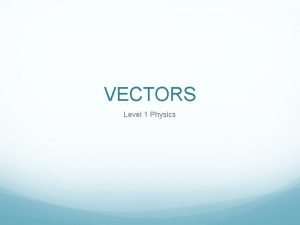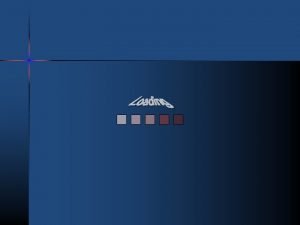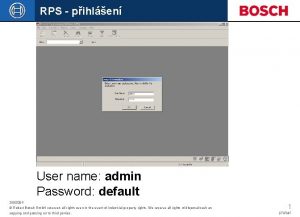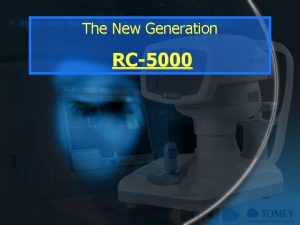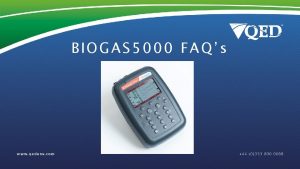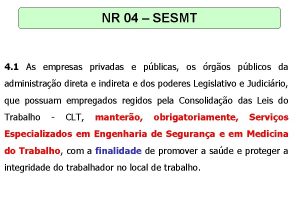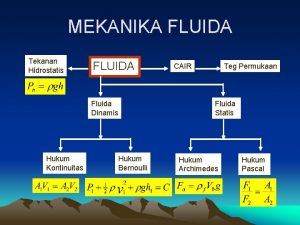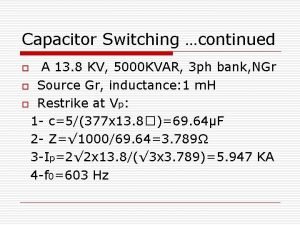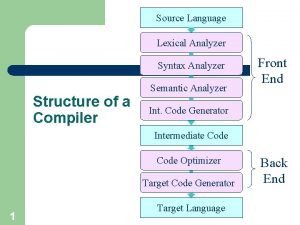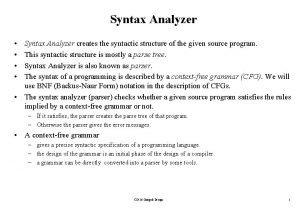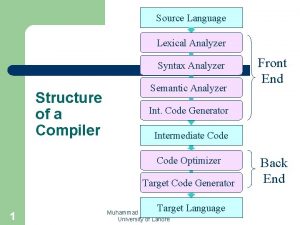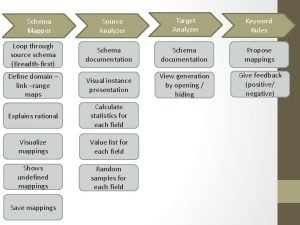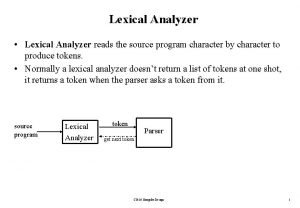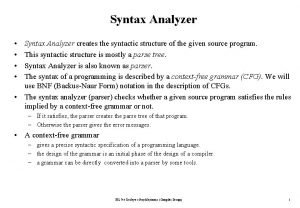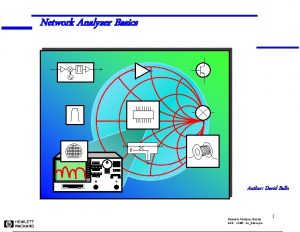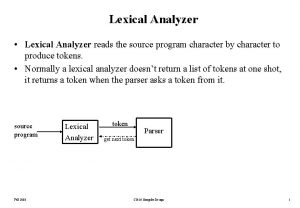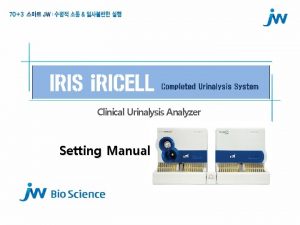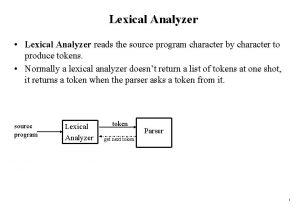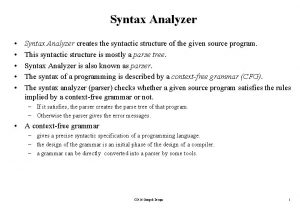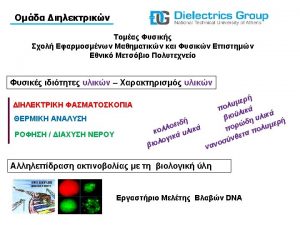CP 5000 Color Pro Color Analyzer CP 5000











































- Slides: 43

CP 5000 ‘Color. Pro’ Color Analyzer CP 5000 Color. Pro Laptop PC Version

Light Measurement Overview

Light Measurement Overview Perceived Light • Light is electromagnetic energy within a narrow range of frequencies. • Each different wavelength of light energy (if seen alone) is perceived by the human eye/brain as a different, fully saturated, color.

Light Measurement Overview Human Sight Characteristics Three characteristics define the way the human eye/brain sees light. • • • Brightness: Perceived light energy level. Hue: Dominant wavelength, color or tint of the color. Saturation: Degree of purity from light of other wavelengths. (zero saturation = white; equal energy of all wavelengths)

Light Measurement Overview Light Measurement Units Two types of measurement units are used to measure light and relate it to the human sight characteristics. Luminance (brightness): • • Foot. Lambert: U. S. unit of luminance (radiated light), 1 lumen per square foot Nit (cd/m 2): S. I. unit of luminance (radiated light), 1 candela per square meter Chromaticity (hue and saturation): • CIE chromaticity coordinates (x, y): From 1931 CIE Chromaticity Diagram (Kelly Chart) CIE = International Commission on Illumination (Commission Internationale De L'Eclairage)

Light Measurement Overview Luminance Measurement • Luminance is a light measurement term closely related to the human sight characteristic of brightness. • The footlambert is the U. S. measurement unit of luminance. It specifies the amount of light energy, per square foot, emitted from a light source (such as a CRT). • The luminance of CRTs, at full brightness and contrast settings, is typically in the range of 30 to 80 footlamberts.

Light Measurement Overview Chromaticity Measurement • Chromaticity is a type of light measurement related to the human sight characteristics of hue and saturation. • The CIE developed a chromaticity diagram which graphically depicts the relationship between hue and saturation. • The diagram plots the pure spectral colors (hues) around the curved border (380 -780 nm). • The results of mixing any of these fully saturated spectral colors are shown at the base and interior of the diagram.

Light Measurement Overview Chromaticity White Reference • The CIE coordinate pair of x = 0. 333, y = 0. 333 (E) specifies the white light (zero saturation) produced by mixing equal light energy of all wavelengths. • The color of any point immediately surrounding the equal energy white point would also appear white, if seen by itself with no other color reference. • The CIE coordinate pair of x = 0. 313, y = 0. 329 (D 65) is the white color which was chosen as the standard white reference for all video and computer display systems.

Light Measurement Overview CIE Chromaticity Diagram • If any two color points are chosen, the colors falling on the connecting line are those colors able to be produced by mixing the chosen colors. • If any three color points are chosen, the area included by the connecting triangle represents the range of colors able to be produced by mixing the three chosen colors (also called the color gamut).

Light Measurement Overview CIE Chromaticity Diagram • Any three colors not lying on a straight line with one another are a set of color primaries. • The three points shown are the colors of the CRT phosphor primaries specified by the NTSC for the U. S. television system. • The connecting triangle encloses the full range of colors able to be produced by a CRT using these color phosphors.

Light Measurement Overview Color Temperature • Color Temperature is a measurement concept that is sometimes also used to specify different nearwhite colors. • Color Temperature is referenced to the color of carbon when it is heated to different temperatures (measured in Kelvin -°Celsius plus 273).

Light Measurement Overview Color Temperature • Colors which are created by heating carbon to different temperatures form a continuous line across the CIE Chromaticity Diagram known as the black body curve. • Only colors exactly on the black body curve are specified by the original absolute color temperature.

Light Measurement Overview Correlated Color Temperature • The correlated color temperature concept was developed later to describe near -white colors not exactly on the black body curve. • A correlated color temperature of 6000 K, for example, can mean any color along the 6000 K correlated color temperature line. • All color measurement devices display correlated, rather than absolute, color temperature.

Light Measurement Overview Tri-Stimulus Human Vision • The human eye sees light through rod and cone type light receptors. • Rod receptors give us black and white vision, especially in small detail and low light. • Red, green, and blue cone receptors, which each have a different response to different frequencies (colors) of light, give us color vision.

Light Measurement Overview Tri-Stimulus Human Vision • The average response of the • cones of the human eye to light across the visible spectrum is shown by the Standard Observer Response graph, developed by the CIE. We call this tristimulus vision, as there are three types of receptors that individually send information to our brain and allow us to perceive different colors for the different mixtures of light energy within the visible spectrum.

Light Measurement Overview Tri-Stimulus Measuring Devices • Tri-stimulus color measurement devices (called colorimeters) work very much the same as the human eye. • Three light sensors receive filtered light from the display to be measured. The spectral filters allow only a certain part of the light spectrum to reach sensor. • The frequency response of each spectral filter duplicates the response of one of the types of cones in the human eye.

Light Measurement Overview Tri-Stimulus Measuring Devices • The measurement information from each of the three light sensors is the same as the information from each of the three types of cones in the eye, only in electronic signal form. • This information allows us to compute a different measurement result for the different mixtures of light energy within the visible spectrum, in a way that duplicates the response of the human eye/brain combination.

Light Measurement Overview Tri-Stimulus Measuring Devices • To accurately predict the response of the human eye to a combination of light energy at different frequencies, a tristimulus color measurement device must “see” light exactly the same way the human eye sees light, at all color frequencies.

Light Measurement Overview Tri-Stimulus Measuring Devices • This is critical, as different display types produce strong peaks of light energy at different frequencies. • If the spectral filters are inaccurate at some frequencies, some displays will be measured inaccurately.

Light Measurement Overview Tri-Stimulus Measuring Devices • If a tri-stimulus colorimeter uses spectral filters that are accurate to the human eye response at all frequencies of light, the instrument will accurately measure all displays of the past, present, and future.

CP 5000 ‘Color. Pro’ Color Analyzer

CP 5000 ‘Color. Pro’ Color Analyzer CP 5000 'Color. Pro' • The CP 5000 'Color. Pro' All. Display Color Analyzer System has spectral filters that are accurate to the CIE standard observer response, at all frequencies of light. • Now you can confidently measure and calibrate any video display ( LCD, DLP, Plasma, CRT, and any future technology) with the CP 5000, knowing that you've aligned it to industry standards and made the display deliver its peak performance.

Color. Pro Overview • Accurately align color tracking and luminance levels on all video displays. • Easy-to-use graphical interface greatly decreases calibration time, with easy to follow display screens. • Continuously updated accurate readings, even at low light, lets you calibrate video displays with flexibility not provided by other measuring instruments. • Portable operation makes it easy to align displays wherever they are installed. • Display Calibration Report for owner documentation and future reference. • Pod holder and extension cable accessories ease projector and video wall adjustments.

Color. Pro Overview CP 5000 'Color. Pro' • The CP 5000 Color Analyzer system includes two measurement sensors, the Color. Pro III and the Color. Pro IV. • The measurement sensors are available with either USB or standard serial connectors.

Color. Pro Overview CP 5000 'Color. Pro' • The Color. Pro III is designed with a precision white diffuser over the light sensors, to integrate incoming light from over a wide viewing angle. • The Color. Pro III sensor is designed to measure all displays except LCD flat panels - this includes CRT and plasma direct-view displays and CRT, LCD, DLP, and LCo. S front and rear projectors.

Color. Pro Overview CP 5000 'Color. Pro' • The Color. Pro IV is designed with individual light pipes leading to each light sensor, to provide a restricted light acceptance angle. • The Color. Pro III sensor is designed to measure all LCD flat panels.

CP 5000 ‘Color. Pro’ Color Analyzer CP 5000 Color. Pro Color Analyzer • To measure a direct view or rear projection display with the CP 5000, attach the Color. Pro III sensor directly to the face of the display (Color. Pro IV for LCD flat panel). • Ambient light will have some effect on the measurement, even on a direct view display, so reduce the room lights to a low level (or drape a cloth over the sensor).

CP 5000 ‘Color. Pro’ Color Analyzer CP 5000 Color. Pro Color Analyzer • To measure a projector’s direct light output with the CP 5000, place the Color. Pro III sensor on the supplied tripod holder. • Position the sensor within a couple inches of the center of the screen, with the white diffusor pointed directly back at the projector. • With the ambient room light totally extinguished, this allows the CP 5000 to accurately measure the color of the projector’s direct light output.

CP 5000 ‘Color. Pro’ Color Analyzer CP 5000 Color. Pro Color Analyzer • To measure the reflected light from a front projection screen, place the Color. Pro III sensor on the supplied tripod holder. • Position the sensor about 12 inches from the center of the screen, with the white diffusor pointed directly at the screen. • At this distance, the white Color. Pro III diffusor averages out the reflected light just ahead of the sensor, effectively eliminating the effects of the sensor’s shadow. • With the ambient room light totally extinguished, this allows the CP 5000 to accurately measure the color of the projector light reflected from the screen.

CP 5000 ‘Color. Pro’ Color Analyzer CP 5000 Color. Pro Color Analyzer • The sensor pod connects to a PC USB port or serial com port 1 -4. • The standard NTSC/ATSC D 65 white reference is able to be selected, plus custom settings are available. • Refresh rate synchronization is provided for testing at a detected display refresh rate (Initial Sample) or at a constant 60 Hz or 50 Hz refresh rate.

CP 5000 ‘Color. Pro’ Color Analyzer CP 5000 Color. Pro Color Analyzer • The unified display screen shows all measurement indicators simultaneously. • A full range of numeric indicators are provided for complete information on display performance. • The graphical displays show adjustment effects at a glance. • The Update/Averaging adjustment slider optimizes the measurement stability at any light level.

CP 5000 ‘Color. Pro’ Color Analyzer CP 5000 Color. Pro Color Analyzer • The CIE Chromaticity Diagram display provides quick visualization of white balance control interaction. • The open box center target defines the selected white reference color coordinates. • The measurement cursor and color “steering lines” show the effects of display adjustments.

CP 5000 ‘Color. Pro’ Color Analyzer CP 5000 Color. Pro Color Analyzer • The Delta RGB analog bar graph display facilitates quick adjustment of video display cutoff and drive controls. • One of the three colors is selectable as the adjustment reference color, to which the other two colors are adjusted. This simplifies adjustment when only two drive controls are provided. • The bar graph resolutions (end points) are easily changed for coarse or fine touchup adjustments.

CP 5000 ‘Color. Pro’ Color Analyzer White Balance/Color Tracking Adjustment Controls • Cutoff/Bias controls adjust color balance at low luminance levels. • Drive/Gain controls adjust color balance at high luminance levels. Drive/Gain Controls Cutoff/Bias Controls

CP 5000 ‘Color. Pro’ Color Analyzer White Balance Adjustment - Cutoff • A display’s cutoff/bias controls are adjusted for color balance at a low luminance level. • These may be mechanical controls, or digital adjustments in the on-screen service menu.

CP 5000 ‘Color. Pro’ Color Analyzer White Balance Adjustment - Drive • A display’s drive/gain controls are adjusted for color balance at a high luminance level. • These may be mechanical controls, or digital adjustments in the on-screen service menu.

CP 5000 ‘Color. Pro’ Color Analyzer CP 5000 Color. Pro Color Analyzer • The Display Calibration Report allows display performance to be captured and documented. • Pre-calibration and postcalibration performance are both easily documented. • Customer information and display information are stored in an MS Access database for easy reference and reports. The data file can be opened in Access or imported into Excel.

CP 5000 ‘Color. Pro’ Color Analyzer Display Calibration Report • The Display Calibration Report printout shows the Pre. Calibration and Post-Calibration color alignment and tracking on a graphical report. • The report provides documentation to the display owner that the display is optimized for most accurate color.

CP 5000 ‘Color. Pro’ Color Analyzer Display Calibration Report • Report page two graphs the display’s color temperature tracking and color error tracking. • The color temperature tracking graph shows the display’s measured color temperature over a range of luminance levels. • The delta color error tracking graph shows the display’s straight line xy error from the desired color coordinates. (A straight line xy error of 0. 010 is shown as a DExy of 10).

CP 5000 ‘Color. Pro’ Color Analyzer Display Calibration Report • Report page three graphs the display’s output luminance over the range of input signal IRE levels. • The non-linear gamma relationship between input signal and light output is shown both numerically and graphically. • Ideally, the display’s gamma should be constant over the entire luminance range. (A CRT display normally has a gamma between 2. 3 and 2. 5. )

CP 5000 ‘Color. Pro’ Color Analyzer Calibration Library • An on-line library of digital service menu access codes is available to Color. Pro owners to simplify white balance calibration without service literature. www. sencore. com/color

CP 5000 ‘Color. Pro’ Specifications General Measurements: Update Rate/Averaging: White References: xy. Y, Luminance (Foot Lamberts or cd/m 2), DRGB, Color Temperature, DExy Adjustable D 65, D 50, E, D 55, D 75, C, 3000 K to 12000 K in 500 K steps, Custom Capture. An unlimited number of custom references can be stored to disk. Host System: Pentium-class PC running Windows 95 or higher. Operating Temperature: 10 to 25°C Operating Relative Humidity: 10 – 80% (non-condensing) Operating Altitude: Sea level to 10, 000 ft. Accuracy Specifications: @ 20°C, relative to NIST-certified reference at D 65 Color. Pro III Accuracy: (@ 65 cd/m 2 minimum) Repeatability: (same-sensor/no-dismount) Luminance Range: xy: ± 0. 002 Y: ± 2% xy: ± 0. 002 Y: ± 1% 0. 05 – 800 cd/m 2, 0. 01 – 233 foot Lamberts Color. Pro IV Accuracy: (@ 65 cd/m 2 minimum) Repeatability: (same-sensor/no-dismount) Luminance Range: Sensor Field of View: xy: ± 0. 004 Y: ± 2% xy: ± 0. 002 Y: ± 1% 3 – 350 cd/m 2, 0. 9 – 102 foot Lamberts 10° (± 5°)

Questions on the CP 5000 ‘Color. Pro’ ? Contact Sencore 800 -736 -267 sales@sencore. com
 The macro pro pro maxcharltonmacrumors
The macro pro pro maxcharltonmacrumors Wvde policy 5000
Wvde policy 5000 A storm system moves 5000 km due east
A storm system moves 5000 km due east Collinear vectors example
Collinear vectors example Ap physics vectors
Ap physics vectors 5000 200
5000 200 Dr 2800
Dr 2800 Bosch rps default password
Bosch rps default password Numberblocks 5000
Numberblocks 5000 Uplogix 5000
Uplogix 5000 Compaq presario 5000
Compaq presario 5000 Nfpa 5000
Nfpa 5000 Year 5000
Year 5000 Un contratista dispone de 5000 horas hombre
Un contratista dispone de 5000 horas hombre Tomey rc-5000
Tomey rc-5000 Feeding 5000 mark
Feeding 5000 mark Nyc energy code tabular analysis sample
Nyc energy code tabular analysis sample Római számok 5000
Római számok 5000 Georg invests $5000 for 14 years
Georg invests $5000 for 14 years Suatu barang jika dijual seharga 5000
Suatu barang jika dijual seharga 5000 Czujka liniowa fireray 5000
Czujka liniowa fireray 5000 Turunnya harga bensin dari 6000 menjadi 5000
Turunnya harga bensin dari 6000 menjadi 5000 Dynatech 5000
Dynatech 5000 Formula for maturity value
Formula for maturity value Biogas 5000
Biogas 5000 Uma maquina termica ciclica recebe 5000 j de calor
Uma maquina termica ciclica recebe 5000 j de calor A storm system moves 5000 km due east
A storm system moves 5000 km due east A storm system moves 5000 km due east
A storm system moves 5000 km due east Ap physics vectors
Ap physics vectors Un contratista dispone de 5000 horas hombre
Un contratista dispone de 5000 horas hombre Epq 5000 word essay example
Epq 5000 word essay example Dimensionamento sesmt acima de 5000
Dimensionamento sesmt acima de 5000 Policy 5000 training
Policy 5000 training Dimensionamento sesmt acima de 5000
Dimensionamento sesmt acima de 5000 Nettefatura işnet
Nettefatura işnet Turunnya harga bensin dari 6000 menjadi 5000
Turunnya harga bensin dari 6000 menjadi 5000 Whats epq
Whats epq Ta 5000
Ta 5000 How many sig figs are in 5000
How many sig figs are in 5000 Hukum mekanika fluida
Hukum mekanika fluida Amx 5000
Amx 5000 Resistol 5000 es una droga
Resistol 5000 es una droga Kv 5000
Kv 5000 Fef25-75 definition
Fef25-75 definition



